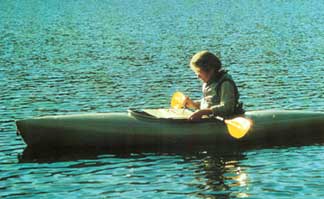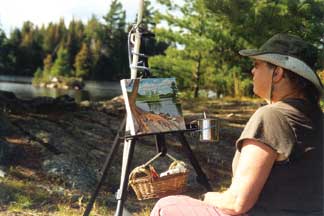|
Three acclaimed artists have banded together
as Wild Women to celebrate their love of nature. Immersed
in the outdoors, painting in all seasons, their works are
infused with the essence of being there. Encouraging viewers
to take part in the experience, the Wild Women exhibit their
finished work in galleries throughout the province.
Joyce Burkholder (that’s me), Kathy
Haycock and Linda Sorensen are the Wild ones. We each have
our own approach to how we paint on location. Often using
home-made or low-cost equipment, the joy and excitement comes
from tromping through the bush, finding an inspiring scene
and capturing the sights, sounds and smells on canvas. We
go on painting adventures. Every time, it is challenging,
stimulating, and absolute fun. An ecstasy comes from inhaling
the scene, from the infusion of all the micro-events going
on while painting. When a graceful heron glides by, a gentle
snow falls, or a brewing storm gathers momentum in the sky,
there is more of a story to paint.
During my many years of painting on location,
I think I have encountered every conceivable form of precipitation,
been in temperatures from one end of the thermometer to the
other, and been consumed by numerous varieties of biting insects…Still,
the great outdoors is my favourite studio.
It helps dramatically to be prepared.
Having stable equipment that can be fairly easily moved in
one or two trips from vehicle to location, and that can be
set up or taken down relatively quickly, makes a big difference.
When I first started painting outdoors I carried everything
I needed in a milk crate, which worked upside-down as my chair,
and I painted on my lap. Now I have graduated to a French-style
standing easel with telescoping metal legs which holds my
brushes and palette. I much prefer the metal legs over wood,
because they don’t swell in humidity. I put the whole
easel in my freezer between painting adventures, so my palette
and brushes don’t dry out.
I paint primarily with oils, as I find
them to be the most agreeable in all conditions, although
I also use water-colours, acrylics and pastels on location.
I try very hard to never use oils inside and inhale unhealthy
solvent fumes in my indoor studio. I use a school-size backpack
to carry all the other ‘stuff’ such as paint tubes,
solvent in an unbreakable stainless steel jar, sketch pad,
rags, apron, latex gloves, hand warmers (winter), sun visor
(summer), thermos of tea (year ’round), etc. My small
folding chair, lunch bag and camera have shoulder straps.
That puts my easel in one hand and a very handy canvas carrier
in the other. Voilà! I am ready to head off in search
of the next grand painting experience.
Kathy Haycock uses a compact laptop painting
box, which holds her palette, brushes and several 11”
x 14” birch panels that she is fond of painting on. Slots
inside the box keep the wet panels from touching. Kathy will
often work on two panels in a day, then complete them in her
log studio after some contemplation. Sometimes, she uses them
as studies to make much larger paintings.
Linda Sorensen has assembled a combination
of a folding metal tripod-type easel that comes with a carrying
case; she attaches a basket that holds her brushes, water
for acrylics, and paint tubes. She holds her disposable paper
easel pad in her left hand while painting with her right.
She carries everything, along with her colourful painting
umbrella, in a camping style dry bag, a great example of being
prepared especially if we are going out in the boat!
We like to be Wild! Having a great story
to tell about a painting done on an adventure is an added
dimension and often deepens the understanding and experience
the viewer has while admiring a finished and framed painting
hanging in a gallery. It may make them want to take it home,
and so the story enriches their lives and furthers an appreciation
and preservation of our precious wilderness.
All three artists’ studios can
be visited every autumn on the Madawaska Valley Studio Tour.
|
|
 Joyce
Burkholder: Joyce
Burkholder:
I recall vividly the time we were in Algonquin Park in January
and it was so cold, minus 30, my oils hardly worked on the
canvas. We had packed up our gear and snow-shoed into a site
on the edge of a drop-off overlooking Tea Lake. I packed the
snow down with my snowshoes and we had a laugh about the rectangle
being our outdoor studio, complete with short walls!
It was a brilliantly sunny and absolutely glorious day. Everything
was so intense: the light, the colours, and the cold. We were
staying in a cabin on the west side of the park, so when we
got back at the end of the day we lit a roaring fire, had
a fabulous meal and supportively critiqued our paintings…a
very important part of the process.
Joyce owns and operates the Wilno Garden Gallery, her
indoor studio, gallery and picture frame shop surrounded by
an enchanting perennial garden. Open from spring till Christmas,
the gallery displays many of her paintings done on location
and pottery by her partner, Dan Hill. www.wilnogardengallery.com
Joyce regularly offers Painting Adventure Workshops including
instruction, encouragement and support in a beautiful wilderness
setting. Please phone 613-756-7890 for more details.
|
|
 Kathy
Haycock: Kathy
Haycock:
Late October is a wonderful time to paint in Algonquin Park.
The tamaracks are lacy gold. The bright yellow poplar and
birch flutter cheerfully in the north wind.
Thus, on a stormy fall day, we parked the Jeep at Rock Lake
and headed into the bush. Unsettled weather means a lively
sky and good painting. Hiking towards a big opening in the
trees, we sought any lake with a grand view. Finally we emerged
on a beautiful sweeping sand beach at the end of a long narrow
lake. On the far shore massive cliffs defined the slopes.
It was perfect. After soaking in the mood, we each set up
and began to paint in the rain. Soon the rain stopped and
the clouds broke up. I continued to paint. When finished,
I stood back in the sun and discovered I had put the likeness
of an angel in the clouds!
These days when the Wild Women go painting, it is with adventure
in mind. We go by foot, boat or canoe, snowshoes, or skis;
by Jeep off-road or down the highway to explore and paint
the Algonquin wilderness we love.
|
|
 Linda
Sorensen: Linda
Sorensen:
The Island
On an earlier camping trip we had scouted out ‘the island’
as a place to return to paint. The island sits in the middle
of Opeongo Lake, South Arm near the West Narrows, and is surrounded
by other small islands. The setting was enchanting in its
allure and we were drawn to its charm. We set up camp with
our party of six a short boat trip away, in sight of our muse.
The boat is a James Bay Freighter that looks like a canoe
with a 9.9 motor on it and holds a lot of gear and people.
When the camp was secure and we loaded our gear—canvas
and paints, easels, cameras, and lunch—we were escorted
by boat and dropped off to paint for the day. The timeless
sunny days of late August filled our hearts and canvases with
an inspired tranquility as we embraced the time-honoured freedom
of the artist’s realm and the natural world. For the
days that we spent on the island, I felt an abandon from my
life back in the world and I drank in each precious moment.
When each day was done, we sounded the boat horn which we
had brought with us and our boatman appeared to take us back
to camp, inevitably and reluctantly. It was time to pack up
the camp and head for home. We headed out and etched in my
mind is the image of the land that I love disappearing behind
us, ’til the next time. Such is the life of an artist!
This is an original story,
first published in The Country Connection Magazine,
Issue 54, Summer/Autumn 2007. Copyright Joyce Burkholder.
RETURN
TO STORY INDEX
RETURN
TO BACK ISSUE PAGE
|

